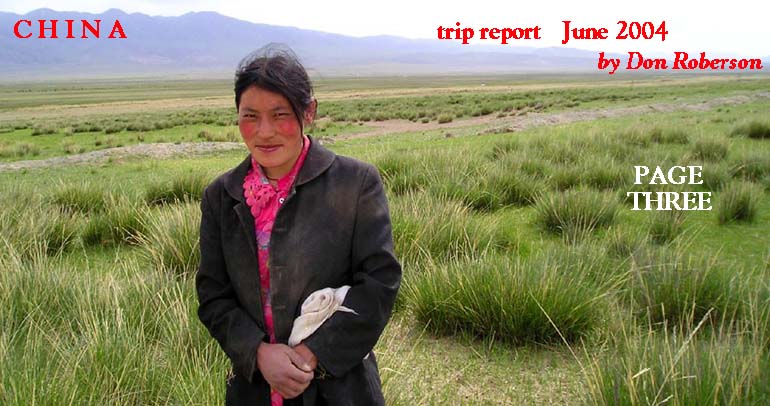| The Tibetan Plateau is a huge region in east-central Asia. Much of
it lies above 10,000' elevation, and vast expanses are remote and wild.
Years ago, in an effort to control and dominate Tibet, the Chinese government
divided Tibet into two different provinces and gave other pieces to existing
eastern provinces. The remaining area that is now commonly considered "Tibet"
is the southern half of this Plateau. Our visit was to the northern portion
of the Plateau in Qinghai [pronounced "Ching-hi"] Province, and this part
is now known as the Qinghai Plateau. Much of our visit was focused around
the southern shores of Qinghai Lake (below), a huge salt lake once
called Koko Nor (spelled various ways; another is Koko Nuur, meaning, I'm
told, "blue sea" in the Mongolian language). The grassy shores of the lake
are now heavily grazed by sheep, goats, and yaks. |
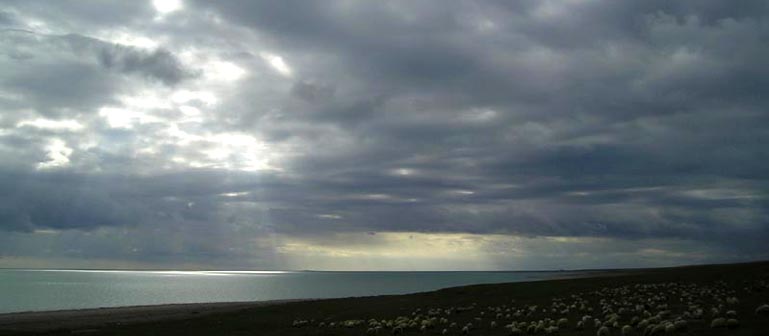
|
 |
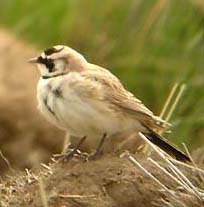
Birds of the Qinghai Plateau grasslands include:
Hume's Groundpecker (left),
Horned Lark (above), and
Isabelline Wheatear (right).
Note how all have evolved a drab pale brown (isabelline) plumage. The
wheatears are recently fledged juvs.
|
|
The Groundpecker is particularly fascinating. It was long considered
the world's smallest jay — it was even called "Tibetan Ground-Jay" — but
many with field experience doubted this relationship. The bird is not the
least bit corvid-like and, in fact, nests in burrows. While we were there
adults were actively gathering insects (above left) to take to the young
in the burrows. Recent evidence (e.g., James et al. 2003) proves that its
closest relatives are the parid (tits & chickadees) and some now consider
it the world's largest tit. I am not convinced. Although it is undoubtedly
related to the parids, might it not be best considered its own monotypic
family? This is how many treat the rather parallel situation with Wallcreeper,
whose ancestors were in the nuthatch lineage but many still consider worthy
of family status.
With the lovely blue-green lake and the endless sky, scenes on the Plateau
can be dramatic. This is further accentuated by a huge set of sand dunes
at the Lake's east end (below). If this were America, these would be preserved
in the "Qinghai Dunes National Monument." |
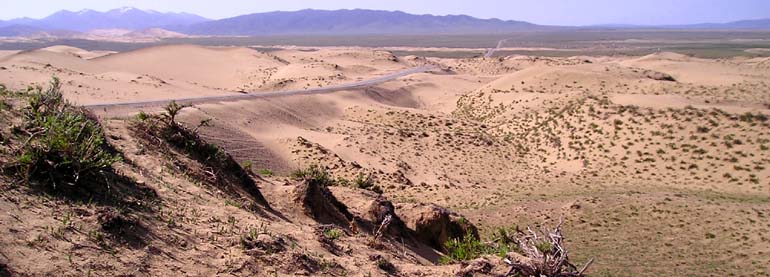
|
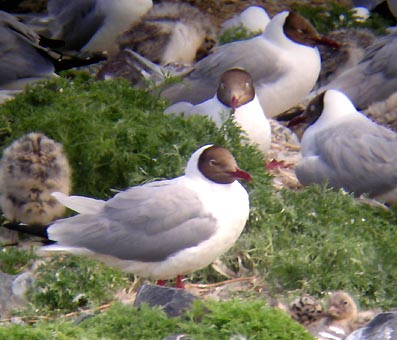 |
The sand dunes are at the east end of Qinghai Lake and so is an adjacent
shallow freshwater lake called Xiao Bei Hu. It was that shallow wetland
that hosted thousands of ducks, a huge nesting colony of Great Crested
Grebes, and the obliging Black-necked Cranes shown on my "north
China cranes" page.
The west end of the lake hosts the famous Bird Island: a protected colony
of (mostly) Brown-headed Gulls (left) but also Bar-headed Geese,
Great Cormorants, and Pallas's Gulls, among others. Bird Island is now
a well-maintained tourist attraction with an entrance fee, strict hours
of operation, and small trolleys to take observers out to well sign-posted
observation platforms. |
|
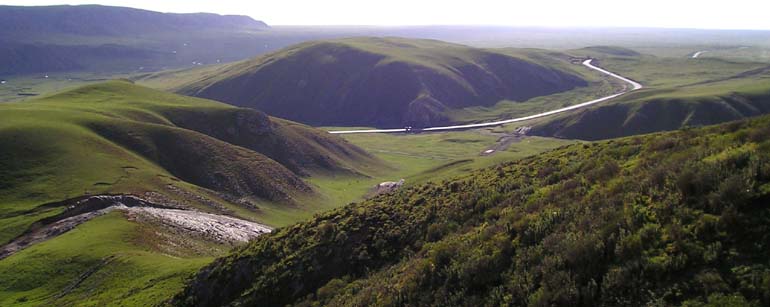
|
| South and west of Qinghai Lake are rolling ridges slowly increasing
in height. The lower slopes and flat bottomlands are all heavily grazed
but the steep ridgelines have patches of short, dense dwarf scrub. This
is habitat to numerous birds. Some highlights included Lammergeier (soaring
overhead), White-tailed Rubythroat, White-browed Tit, White-browed Tit-Warbler,
Beautiful & Streak Rosefinches, and the enigmatic Pink-tailed Rosefinch
(photo on page
one of trip report).
These foothills are also cut by small canyons and some of them have
scrub habitat and steep canyon walls. We visited what was dubbed 'Paul's
Canyon' (below right). It was full of birds, including Blue-fronted
Redstart (below left), the rare Ala Shan Redstart (photos on page
one and on a separate "north
China redstarts" page), Tibetan Partridge, Wallcreeper, and Tibetan
Snowfinch. |
|
|
| A half-day's drive to the southwest — after climbing up and over 12,500'
Rubber Mt. Pass — is the flat and very dry Caka Valley. Here both the habitat
and the avifauna changed dramatically. We were up the next day at dawn
(as always), this time accompanied by the same Afghan soldiers who guard
Kyber Pass (below) . . . oh, sorry, that's just David Fisher
in a borrowed Chinese Army greatcoat to help him fight off a cough &
cold, and that's not a rifle but David's scope . . . . |
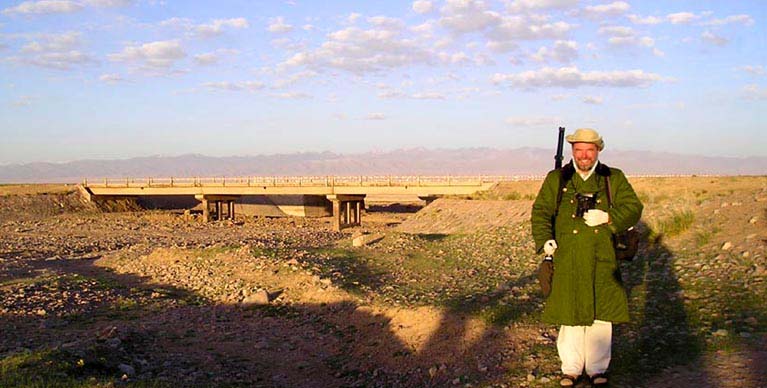
|
| We worked this arid country until we'd located all the major specialties
— Przevalski's Partridge, Great Rosefinch, and, especially Mongolian Ground-Jay
(photo on page
one of trip report). We also came upon this adult Blanford's (Plain-backed)
Snowfinch carrying food and looking lost, until two half-grown youngsters
emerged from a tiny shrub to beg (below)! |
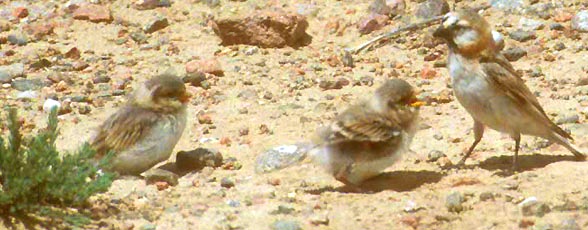
|
We returned to Xining after leaving the Qinghai Plateau. We had earlier
spent a morning birding in a isolated spruce/fir/birch forest in mountains
north of Xining (Bao Qo) but this time we were destined to drive over 11,500'
Huzu
Pass (below) to reach our campsite in Huzu Bei Shan national
park. We left Xining at 4 a.m. so we would reach the pass by dawn with
hopes of hearing and seeing snowcock and other pheasants. This was an excellent
strategy: we watched a family party of Tibetan Snowcock well above the
roadway, and grazing Common and Blue Eared-Pheasants below the road. Other
highlights included Kessler's Thrush (photo on page
one of trip report), Chestnut Thrush, Plain & Elliot's Laughingthrushes,
White-browed Rosefinch, and a White-browed Tit nesting in a hole in a road-cut.

|
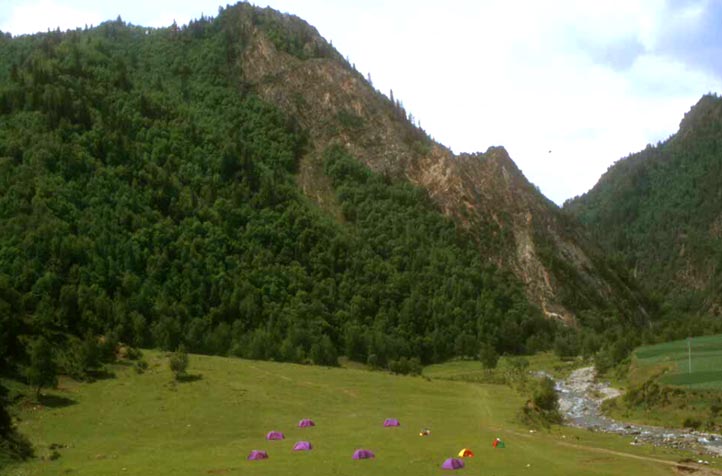
|
Our campsite was nestled between steep forested hills and a rushing
river (above). We had individual tents provided by the tour operator but
each brought our own sleeping bag. Alas, mine was much too thin for the
freezing cold at night here at 8000' elevation, and by day two of camping
I had succumbed to the cough & cold that had dogged Bob and David and
Arnie for the preceding week.
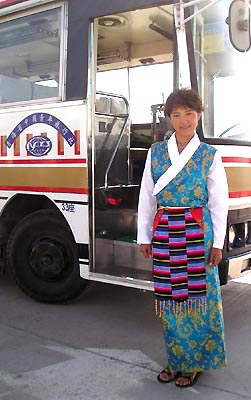 |
Ms. Q-Y. Wang, our local travel agent up on the Plateau (left; shown
here in the traditional dress she wore the final day), was also our cook
at the camp. Despite the difficulties, we had fine meals. And our bus driver
got this huge bus down along the river. |
|
And the river itself (above right with Sheila & Jack) was delightful.
Two species of dipper frequented the stream, and there was almost always
a redstart perched on one of the boulders: White-capped Water Redstart
or Plumbeous or Hodgson's (photos on my "China
redstarts" page). |
 The
birding around camp (the 'upper canyon' area) and a couple kms downstream
(the 'lower canyon') was excellent. It was a rich mix of spruce, fir, junipers
and birch; dominate songs included Greenish and Gansu Leaf-Warbler. The
forest had a few pairs of White-cheeked (Przevalski's) Nuthatch
(near right; a rarely-photographed Chinese endemic) and a wide-ranging
Black
Woodpecker (far right). Also present were Blue Eared & Blood Pheasants
and Chinese Grouse (photos/sketches on page
one of trip report), Chestnut Thrush, and White-throated Redstart (photos
on a north
China redstart page of trip report). The
birding around camp (the 'upper canyon' area) and a couple kms downstream
(the 'lower canyon') was excellent. It was a rich mix of spruce, fir, junipers
and birch; dominate songs included Greenish and Gansu Leaf-Warbler. The
forest had a few pairs of White-cheeked (Przevalski's) Nuthatch
(near right; a rarely-photographed Chinese endemic) and a wide-ranging
Black
Woodpecker (far right). Also present were Blue Eared & Blood Pheasants
and Chinese Grouse (photos/sketches on page
one of trip report), Chestnut Thrush, and White-throated Redstart (photos
on a north
China redstart page of trip report). |
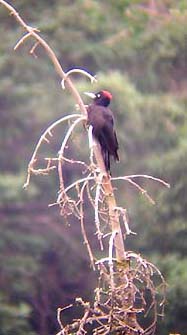
|
Blood Pheasant proved to be the 5000th world bird for participant
Denis
Blamire (below left with Paul Holt on the pheasant track). Also immediately
thereafter, local teens appeared to celebrate the achievement! This young
girl proved to be quite drunk but well-meaning.
|
| As for your humble reporter, the quest for 5000 — or half of the birds
in the world — fell 4 species short this trip. But just this week the American
Ornithologists' Union split Cackling from Canada Goose, so that makes it
but three more . . . Will those brighten the next foreign trip? Or
will they be ticked from my armchair while reading the journals? Hard to
say. But one could hardly have chosen a better species for #5000 than Blood
Pheasant! |
| So I must conclude this was a very successful trip. I actually saw
9 of 10 species I had chosen as 'most-wanted' before the trip, and then
had enjoyed others that I had not even thought likely (e.g., Great Bustard,
Schrenk's Bittern). And the digiscoping efforts turned out to be a major
source of enjoyment. I leave you with this Siberian Rubythroat scoped
near the camp. . . . |

|
|
| The links below include many more photographs.
PHOTOS: All photos on this page are © 2004 Don Roberson;
all rights reserved. Many other shots from this trip are scattered about
this web site. Check particularly bird families, mammals, and herps listings. |
Literature cited:
Alström, P., U. Olsson, and P.R. Colston. 1992. A new
species of Phylloscopus warbler from central China. Ibis 134: 329-334.
Alström, P., U. Olsson, and P.R. Colston. 1997. Re-evaluation of
the taxonomic status of Phylloscopus proregulus kansuensis. Bull.
Brit. Orn. Club 117: 177-193.
Birdlife International. 2000. Threatened Birds of the World. Lynx Edicions,
Barcelona, Spain.
Dickinson, E.C., ed. 2003. The Howard & Moore Complete Checklist
of the Birds of the World. 3rd ed. Princeton Univ. Press, Princeton, N.J.
James, H.F., P.G.P. Ericson, B. Slikas, F-M. Lei, F.B. Gill, and S.L.
Olson. 2003. Pseudopodoces humilis, a misclassified terrestrial
tit (Paridae) of the Tibetan Plateau: evolutionary consequences of shifting
adaptive zones. Ibis 145: 185-202.
MacKinnon, J., and K. Phillipps. 2000. A Field Guide to the Birds of
China. Oxford Univ. Press, Oxford.
Zheng, G., Song, Zhang, Zhang, and Guo. 2000. A new species of flycatcher
(Ficedula) from China. J. Beijing Normal Univ. (Nat. Sci.) 36 (3):
405-409.
|
| TOP
GO TO TRIP
REPORT PORTAL
GO TO LIST OF BIRD
FAMILIES OF THE WORLD
GO TO ENDANGERED
& THREATENED BIRDS ENTRY PAGE
GO TO MONTEREY COUNTY
PAGE
GO TO HOME PAGE
|
